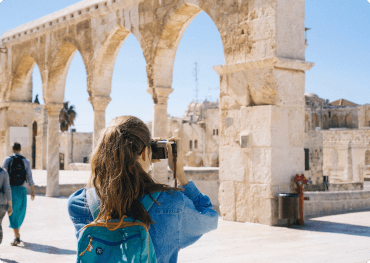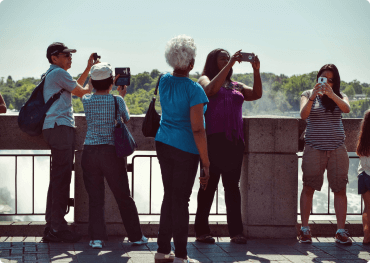
CL 525
Package Details
Day 1: Flight from your home country to Shiraz
We prepare ourselves for a fabulous trip to Great Persia. Afternoon arrival to Shiraz, after custom formality, meet and assist at airport and transfer to the Hotel. Evening visit Hafez & Saadi tomb.
O/N: Shiraz
Day 2: Shiraz
After breakfast, full day visit Shiraz:
O/N: Shiraz
Shāh Chérāgh is a funerary monument and mosque in Shiraz, Iran, housing the tomb of the brothers Ahmad and Muhammad, sons of Mūsā al-Kādhim and brothers of ‘Alī ar-Ridhā. The two took refuge in the city during the Abbasid persecution of Shia Muslims.
The Nasir-ol-Molk Mosque, also known as the Pink Mosque, is a traditional mosque in Shiraz, Iran. It is located at the district of Gowad-e-Arabān, near Shāh Chérāgh Mosque.
The mosque includes extensive colored glass in its facade, and displays other traditional elements such as the Panj Kāse ("five concaved") design. It is named in popular culture as the Pink Mosque due to the usage of considerable pink color tiles for its interior design.
The mosque was built during the Qajar era, and is still in use under protection by Endowment Foundation of Nasir ol Molk. It was built from 1876 to 1888, by the order of Mirzā Hasan Ali (Nasir ol Molk), a Qajar ruler.
Zandieh set of buildings that included the market, and the bathroom is Vakil Mosque of Shiraz, as follows
Vakil Bazaar in Shiraz, Iran is one of the most traditional and historical markets at the behest of Karim Khan Zand (1172 - 1193 AD) and is now at the center of the city (East Martyrs' Square) is located. Lawyer historic mosque and baths are also next to the market.
Bathroom lawyer Karim Khan Zand was built by the Zand period. The bathroom in the center of the city and other nearby buildings Zand period such as markets and mosques lawyer's lawyer. The interesting part is the bathroom alcove called for the king Bvdh. part of the building number 917 has been registered in the national index Iran.
Vakil Mosque in Shiraz Zand set of buildings, next to bathrooms is a lawyer at the center of the city. It is one of the beautiful buildings and the Zand period is very strong, which is important in terms of art and architecture, the mosque order of Karim Khan Zand and has made plans for both the southern and eastern porch and yard are two. South yard integrated with stone columns and architectural characteristics from the spiral of Attraction is the mosque, which has 48 stone pillars integrated
Day 3: Shiraz
After breakfast, drive to Marv dasht (80 km) and visit Perspolis & Nagh e Rostam.
Evening return to Shiraz.
O/N: Shiraz
Persepolis the name of one of the ancient cities of Iran that joined over the years, the capital’s stately and ceremonial monarchy at the time of the Achaemenid Empire was. In this ancient city called Persepolis palace that during the reign of Darius, Xerxes and Artaxerxes was built and was built for about 200 years. On the first day of the New Year, many groups from different countries representing Satrapyha or governments gathered in Persepolis with diverse took offerings and gifts were presented to the king.
Persepolis in 518 BCE as the new capital of the Achaemenid the gamers began. Founder of Persepolis, Darius was, of course, after his son Xerxes and his grandson Artaxerxes I to extend this series to expand it added. Many existing knowledge about the history and culture of the Achaemenid stone inscriptions and Flznvshthhayy is available for the palaces and on the walls and the tablet is engraved Sumner has estimated that the plain of Persepolis which contains 39 residential camp was in the Achaemenid period 43, 600 people had. Historians believe that Alexander the Macedonian commander Greek in 330 BC, invaded Iran and burned Persepolis and probably a large part of the books, Achaemenid art and culture destroyed by it. However, the ruins of this place is still up and archeology of its ruins signs of fire and rush to acknowledge it.
This place since 1979, one of Iran's record on the UNESCO World Heritage is.
Naqsh-e Rustam name of the ancient collection Zangiabad village located in the northern city of Shiraz in Fars province of Iran , which is 6 kilometers from Persepolis is located. Yadmanhayy the archaeological site of the Elamite , Achaemenid and Sassanid in its place and has around 1200 BC to 625 AD was the focus of attention because the tomb four kings Achaemenid, Sassanian reliefs of a number of major events, building the Kaaba of Zoroaster and Vyranshdhay relief from the Elamite era in this place and in the Sassanid era, Naqsh-e Rustam area of religious and national importance have been.
In the past, this place was Dogonbadan Segonbad or among the people of the region were caught by the names of the mountain, the mountain was also called Nfsht pool or mountains after the Iranians and possibly the name of Naqsh-e Rustam between Rostam , the hero of Shahnameh and communicate the Sassanid kings were Sngngarhhay It was to this place.The oldest role in Naqsh-e Rustam is the Elamite period and the king and queen of the gods and goddesses were portrayed, but later in the Sassanid era, Bahram II parts of it wiped and his role and his courtiers erected in its place. Kaaba of Zoroaster and Brjmannd in the Mhvthast stone building that was built during the Achaemenid period is likely to be unclear and its application is based on three corners of the building has two inscriptions of Shapur I and Kartir written that historically are of great value.
Four Tomb dungeon in the bosom of the Mountain of Mercy have been dug that belonged to Darius the Great , Xerxes , Artaxerxes I , and Darius II that all of them have the same properties.
Ardashir the first one who in this area, Sngngarhay shaved and Tajgyryash scene of Ahura Mazda recorded. He also Tajgzaryshan Sassanid kings scenes or descriptions of battles and Aftkhartshan on the breast of the mountain. That Artaxerxes and his son Shapur II Nqshbrjsthhayy counterparts in the Achaemenid reliefs in Naqsh-e Rustam shaved, probably in imitation of the past have been the political and cultural sequences.
Day 4: Shiraz - Yazd
After breakfast, drive to Yazd. En route visit Pasargad.
Evening arrival to Yazd.
O/N: Yazd
Pasargadae World Heritage collection is a set of ancient structures Brjaymandh from the Achaemenid the city of Pasargadae in Fars Province lies.
This total includes buildings such as Tomb of Cyrus the Great , Pasargadae mosque , declared the king's garden , the palace gates , bridges, levee House , House suite , two pavilions , waterfront, garden cress, Tomb of Cambyses , defensive structures Tel bed , inn Mozaffari , sacred ground and Bolaghi Gorge is.
This set the fifth set is registered in the World Heritage List in Iran at a meeting of UNESCO in July of 1383 in China was held due to many factors hundred per cent on the World Heritage List was registered.
In 529 BC, Cyrus the tribes of the Scythians in Central Asia (North East of Iran) attacked and are at war with massagetae was killed. He was buried in Pasargadae.
Day 5: Yazd
After breakfast, full day visit Yazd.
O/N: Yazd
Yazd fire whereabouts of the Zoroastrian sacred fire in the city of Yazd and Temple Zoroastrians residing in the city. The main building temples on height of about 21 meters off the ground and in the large yard trees evergreen cypress and pine covered, is located. Figure Forouhar and stone capitals that gives it a special beauty blue pond in front of the building. The temples of properties Altar of the water.
The Hall's main building and a wall of stone capitals flowering gems work of artists from Isfahan. This rock artists in Isfahan shaved and then to Yazd have. Tile journalist Forouhar on the entrance, a tile Yazdi artists and architecture of this building of architecture Corp fire temples was persuaded impact.
Fire inside the fire burns more than 1,500 years remains bright. This fire is the fire Frvz·hay Carian temple in LARESTAN that Aghda Yazd was brought and kept clear there was nearly 700 years and then in 522 of Aghda in Ardakan Ardakan, Yazd were also nearly 300 years, and in year, 852 ducks were taken to the city.
First, in a neighborhood called " Khalaf Ali Khan " a great priest in the house called " priest Adhargushasb shooter " was held in the year 1313 after the construction of the temple was brought into it.
Yazd Water museum in Yazd province is one of the most spectacular museums in the city due to its proximity to the Amir Flint is a great tourist interest.
Yazd Water Museum At the same time holding the First International Conference on Ardbyhsht 1379 Hijri aqueduct opened in the city of Yazd. The museum is the perfect place for recognizing historical buildings and monuments related to the water. The museum is located in the north of the city of Yazd Amir Chqmaq.
The museum subterranean drilling equipment, express and equipment to measure the volume of water in the canals of lighting, water and devoted documents dealing with old letters, manuals and documents mirab water distribution, water storage containers and many appliances and other valuable objects are kept. The museum is set up in the historic home Hatter.
Alexander prison or school is a school with about eight centuries old, in fact, that in the neighborhood Fhadan the city of Yazd in the vicinity of the tomb of the twelve Imams actually been produced. The built in 631 AD by the famous mystic Zia Hussain Razi was built in 705 AD and was completed by his sons Majd Ali Hassan and Shafaruddin.
Parts of the building can be a hole with a diameter of about 2 meters in the middle of the school yard which has a depth of about 5 meters leads to the basement, dome of the monument to the height of 18 meters and has Gchbryhay and decorating beauty with golden and blue color that much of it has been undermined.
The building is raised on stories dating from making it to the attack of Alexander the Macedonian to Iran than that of the building that was later repurposed been used as a prison and has been used as a school.
Tower of Silence Cellar Zoroastrians , called the Tower of Silence Tower also known as off. The crypt at 15 kilometers southeast of Yazd Safaieh around the region and on a low-lying sedimentary mountain called Mount crypt is located.
The function of this tower was to bury the corpses. In the distant past corpses to the top of the tower meant to be bird feed. Later Myrykhthand bones in a pit. This was done to prevent soil contamination.
Day 6: Yazd – Isfahan
After breakfast, drive to Isfahan (320 km). In the way visit Nain. Evening arrival to Isfahan, check in hotel
O/N: Isfahan
The Jāmeh Mosque of Nā'īn is the grand, congregational mosque (Jāmeh) of Nā'īn city, within Isfahān Province of Iran. Although the mosque is one of the oldest in Iran, it is still in use and is protected by Iran's Cultural Heritage Organization.
The mosque is one of the oldest in Iran, dating back to the 9th century. The interiors however are Seljuki in brick craftsmenship, and therefore allude to the 11th century.
Day 7: Isfahan
After breakfast, full day visit Isfahan: Naghse Jahan Sq (Imam Mosque , sheikh Lotfollah , Aliqapoo,Grand Bazzar). Evening visit old bridiges ( Khajoo & Si o Se Pol)
O/N: Isfahan
Naqsh-e Jahan Square known as Imam Square, formerly known as Shah Square, is a square situated at the center of Isfahan city, Iran. Constructed between 1598 and 1629, it is now an important historical site, and one of UNESCO's World Heritage Sites. It is 160 meters (520 ft.) wide by 560 meters (1,840 ft) long (an area of 89,600 square meters (964,000 sq. ft.)). The square is surrounded by buildings from the Safavid era. The Shah Mosque is situated on the south side of this square. On the west side is the Ali Qapu Palace. Sheikh Lotf Allah Mosque is situated on the eastern side of this square and at the northern side Keisaria gate opens into the Isfahan Grand Bazaar.
Ali Qapu is a grand palace in Isfahan, Iran. It is located on the western side of the Naqsh e Jahan Square, opposite to Sheikh Lotfollah Mosque, and had been originally designed as a vast portal. It is forty-eight meters high and there are seven floors, each accessible by a difficult spiral staircase. In the sixth floor, Music Hall, deep circular niches are found in the walls, having not only aesthetic value, but also acoustic.
Fresco from the portico of the palace, depicting a Persian woman
The name Ali Qapu, from Arabic "Ālī" (meaning "imperial" or "great"), and Turkic "Qāpū" (meaning "gate"), was given to this place as it was right at the entrance to the Safavid palaces which stretched from the Naqsh e Jahan Square to the Chahar Baq Boulevard. The building, another wonderful Safavid edifice, was built by decree of Shah Abbas I in the early seventeenth century. It was here that the great monarch used to entertain noble visitors, and foreign ambassadors. Shah Abbas, here for the first time, celebrated the Nowruz (Iranian New Year) of 1006 AH / 1597 C E.
Ali Qapu is rich in naturalistic wall paintings by Reza Abbasi, the court painter of Shah Abbas I, and his pupils. There are floral, animal, and bird motifs in his works. The highly ornamented doors and windows of the palace have almost all been pillaged at times of social anarchy. Only one window on the third floor has escaped the ravages of time. Ali Qapu was repaired and restored substantially during the reign of Shah Sultan Hussein, the last Safavid ruler, but fell into a dreadful state of dilapidation again during the short reign of invading Afghans. Under the reign of Nasir Ol Din Shah e Qajar (1848–96), the Safavid cornices and floral tiles above the portal were replaced by tiles bearing inscriptions.
Sheikh Lotfollah Mosque is one of the architectural masterpieces of Safavid Iranian architecture, standing on the eastern side of Naghsh-i Jahan Square, Isfahan, Iran.
Construction of the mosque started in 1603 and was finished in 1619. It was built by the chief architect Shaykh Bahai, during the reign of Shah Abbas I of the Safavid dynasty.
The Bazaar of Isfahan or Isfahan Bazaar is a historical market in Isfahan, Iran, one of the oldest and largest bazaars in the Middle East, dating back to the 17th century. The bazaar is a vaulted two-kilometre street linking the old city with the new.
The Bazaar of Isfahan is located in downtown old Isfahan, Iran, in the northern section of the Naqsh-e Jahan Square. The main entrance called Qeisarieh and you can walk all along to the Friday mosque Jameh Mosque the oldest mosque in Isfahan, and one of the oldest in Iran.
Before you enter the Grand Bazaar, if you look back you will see the magnificent view of the square, which is one of the biggest squares in the entire world. All around the square are bazaars full of magnificent Persian handicrafts.
Khaju Bridge is a bridge in the province of Isfahan, Iran, which has been described as the finest in the province. It was built by the Persian Safavid king, Shah Abbas II around 1650, on the foundations of an older bridge. Serving as both a bridge, and a dam (or a weir), it links the Khaju quarter on the north bank with the Zoroastrian quarter across the Zayandeh River. Although architecturally functioning as a bridge and a weir, it also served a primary function as a buildingand a place for public meetings. This structure was originally decorated with artistic tilework and paintings, and served as a teahouse.
Allāhverdi Khan Bridge, popularly known as Si-o-seh pol “The bridge of thirty-three spans” is one of the eleven bridges of Isfahan, Iran and the longest bridge on Zayandeh River with the total length of 297.76 metres (976.9 ft). It is highly ranked as being one of the most famous examples of Safavid bridge design.
It was constructed by the finance and the inspection of Allahverdi Khan Undiladze chancellor of Shah Abbas I, an ethnic Georgian, it consists of two rows of 33 arches from either sides, left and right.
There is a larger base plank at the start of the bridge where the Zayandeh River flows under it, supporting a tea house which nowadays is abandoned due to the shortage of water and the river drought.
Day 8: Isfahan
After breakfast, visit Vank and Evening is free for shopping.
O/N: Isfahan
Vank Cathedral also known the Church of the Saintly Sisters, is a cathedral located in the New Julfa district of Isfahan, Iran. It is commonly referred to as the Vank (Վանք), which means "monastery" or "convent" in Armenian language.
The cathedral was established in 1606, dedicated to the hundreds of thousands of Armenian deportees that were resettled by Shah Abbas I during the Ottoman War of 1603-1618.
The varying fortunes and independence of this suburb across the Zayande River and its eclectic mix of European missionaries, mercenaries and travelers can be traced almost chronologically in the cathedral's combination of building styles and contrasts in its external and internal architectural treatment.
Day 9: Isfahan – Abyaneh - Kashan
After breakfast, check out hotel and drive to Kashan (240 km), in the way visit Abyaneh village.
O/N: Kashan
Abyaneh is a village in Barzrud Rural District, in the Central District of Natanz County, Isfahan Province, Iran.
At the 2006 census, its population was 305, in 160 families. Characterized by a peculiar reddish hue, the village is one of the oldest in Iran, attracting numerous native and foreign tourists year-round, especially during traditional feasts and ceremonies.
An Abyanaki woman typically wears a white long scarf (covering the shoulders and upper trunk) which has a colourful pattern and an under-knee skirt. Abyunaki people have persistently maintained this traditional costume. On top of the village sits the ruins of a Sasanid era fort.
The dialect of the people of Abyaneh has preserved some characteristics of the Middle Persian language, the language of theSassanian Persia.
Day 10: Kashan – Qom - Tehran
Afrter breakfast visit Kashan and afternoon drive to Tehran, in the way visit Qom.
O/N: Tehran
Fin Garden, or Bagh-e Fin, located in Kashan, Iran, is a historical Persian garden. It contains Kashan's Fin Bath, where Amir Kabir, the Qajarid chancellor, was murdered by an assassin sent by King Nasereddin Shah in 1852. Completed in 1590, the Fin Garden is the oldest extant garden in Iran.
The origins of the garden may be anterior to the Safavid period; some sources indicate that the garden has been relocated from another place, but no clear picture of it has been found.
Home Borujerdian the historic city of Kashan is. The building is located in the neighborhood Sultan Mir Ahmad and in the second half of the 13th century Hijri built in Qajar era and was registered under the number 1083 in the national index.
The house has a beautiful crescent-shaped symmetrical vents on the roof of the hall and pergola on one of the most beautiful manifestations of Persian architecture to display it. So that the inscriptions on all four sides of the hall, the building dates back to 1292 BC E…
Paintings, valuable and Gchbryhay this house, under the Sani-ol-Molk, the great Iranian painter and uncle Kamalolmolk been implemented. The owner of the house, Haj Seyed Mehdi Natanz Natanz businessmen residing in Kashan and architect of the master Ustad Ali Maryam was. Because of his many trips to the city of Boroujerd have known Boroujerdi. He loved the girl’s Tabatabai Tabatabai also one of the largest carpet merchant, and then leaves to consent to the marriage condition. His beautiful home which is now called the house Tabatabaian known as lived and Mehdi says he must build a house like my house to get my daughter to Hmsryt in. Mehdi also accepts and ends after 7 years to build the inner courtyard and living at home after 11 years in the main hall is completed. Boroujerdi House in Kashan Cultural Heritage Administration is now home.
Brvjrdyhay historic house in Kashan in terms of popularity tourist attraction as a top choice UNESCO in 2015 and 2016 respectively.
Day 11: Tehran
After breakfast, full day visit Tehran: Golestan Palace, Grand Baazar, Abgineh Museum.
O/N: Tehran
The Golestan Palace is the former royal Qajar complex in Iran's capital city, Tehran.
The oldest of the historic monuments in Tehran, and of world heritage status, the Golestan Palace belongs to a group of royal buildings that were once enclosed within the mud-thatched walls of Tehran’s Historic Arg (citadel). It is a masterpiece of beautiful garden and buildings consist of collection of Iranian crafts and European presents from 18th and 19th century.
Golestan Palace Complex consists of 17 structures including palaces, museums, and halls. Almost all of this complex was built during the 200 years ruling of Qajarian kings. These palaces were used for many different occasions such as coronation and other important celebrations. It also consists of three main archives as the royal photographic archive collection 'Album khane', the royal library of manuscripts 'Ketabkhane Nosakhe khati' and the archive of documents 'Markaze asnad'.
The Grand Bazaar is an old historical market in Tehran, the capital of Iran.Located at the Arg Square in Southern Tehran, it is split into several corridors over 10 km in length, each specializing in different types of goods, and has several entrances, with the main being the entrance of Sabze Meydan.
In addition to shops, the Grand Bazaar of Tehran has contained banks, mosques and guest houses.
Museum of Glass is one of the museums in Tehran is. This historic house built in Qajar era and in Tehran, Avenue C bar is located. The effect on 7 Persian date Ordibehesht 1377 with registration number 2014 as one of the national monuments has been registered. Museum of Glass Museum of Glass and pottery.
This sets up 1330 home and work Qvamalsltnh and then for seven years was in the hands of the Egyptian Embassy. Then, to the Embassy of Afghanistan, Bank of Commerce, in 1355 with the cooperation of Iranian and Austrian engineers began to change.
Day 12: Departure
After breakfast, check out hotel and transfer to International airport to fly back to your home.
Details
Pellentesque accumsan magna in augue sagittis, non fringilla eros molestie. Sed feugiat mi nec ex vehicula, nec vestibulum orci semper. Class aptent taciti sociosqu ad litora torquent per conubia nostra, per inceptos himenaeos. Donec tristique commodo fringilla. Duis aliquet varius mauris eget rutrum. Nullam sit amet justo consequat, bibendum orci in, convallis enim. Proin convallis neque viverra finibus cursus. Mauris lacinia lacinia erat in finibus.
Pellentesque accumsan magna in augue sagittis, non fringilla eros molestie. Sed feugiat mi nec ex vehicula, nec vestibulum orci semper. Class aptent taciti sociosqu ad litora torquent per conubia nostra, per inceptos himenaeos. Donec tristique commodo fringilla.
- Specilaized Bilingual Guide
- Private Transport
- Entrance Fees
- Box Lunch,Water,Dinner and Snacks
Pellentesque accumsan magna in augue sagittis, non fringilla eros molestie. Sed feugiat mi nec ex vehicula, nec vestibulum orci semper. Class aptent taciti sociosqu ad litora torquent per conubia nostra, per inceptos himenaeos. Donec tristique commodo fringilla.
- Specilaized Bilingual Guide
- Private Transport
- Entrance Fees
- Box Lunch,Water,Dinner and Snacks
Pellentesque accumsan magna in augue sagittis, non fringilla eros molestie. Sed feugiat mi nec ex vehicula, nec vestibulum orci semper. Class aptent taciti sociosqu ad litora torquent per conubia nostra, per inceptos himenaeos. Donec tristique commodo fringilla.
- Specilaized Bilingual Guide
- Private Transport
- Entrance Fees
- Box Lunch,Water,Dinner and Snacks
Pellentesque accumsan magna in augue sagittis, non fringilla eros molestie. Sed feugiat mi nec ex vehicula, nec vestibulum orci semper. Class aptent taciti sociosqu ad litora torquent per conubia nostra, per inceptos himenaeos. Donec tristique commodo fringilla.
- Specilaized Bilingual Guide
- Private Transport
- Entrance Fees
- Box Lunch,Water,Dinner and Snacks
Pellentesque accumsan magna in augue sagittis, non fringilla eros molestie. Sed feugiat mi nec ex vehicula, nec vestibulum orci semper. Class aptent taciti sociosqu ad litora torquent per conubia nostra, per inceptos himenaeos. Donec tristique commodo fringilla.
- Specilaized Bilingual Guide
- Private Transport
- Entrance Fees
- Box Lunch,Water,Dinner and Snacks






















